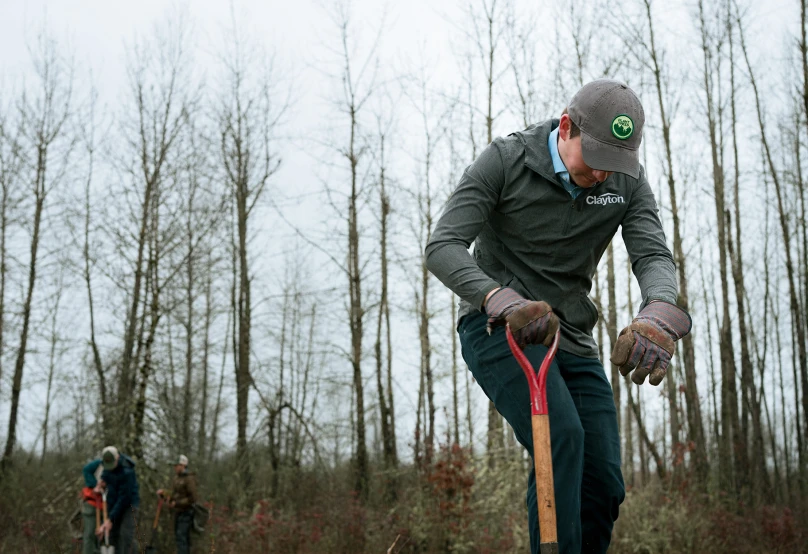Social Responsibility
Building a Better Tomorrow - Clayton & The Arbor Day Foundation
March 17, 2025

Through our partnership with the Arbor Day Foundation®, Clayton is helping build a better tomorrow for both people and the planet we call home, supporting reforestation initiatives across the country. We know the positive impacts of these efforts contribute towards restoring forest ecosystems and can create effects in surrounding communities. Trees have the power to clean and filter water and strengthen soil, both in forests and in neighboring communities. They also support by helping to establish a stable habitat for varying species of wildlife, and foster biodiversity. These long-term benefits and the opportunity to do good in the communities we serve are why we have committed to plant another 1.07 Million trees in 2025, representing one tree for every estimated tree used to build our homes in 2024.
Recognizing that forests play a vital role in our environment and our communities — and understanding our responsibility as global citizens — Clayton and the Arbor Day Foundation launched an important partnership in 2022 to plant trees in forests of great need. These reforestation efforts are in strategic locations to help restore critical ecosystems and foster a long-term, sustainable impact.
In partnership with the Arbor Day Foundation, Clayton has supported 27 reforestation projects in 15 states, planting over 4.47 million native species trees and helping to restore over 8,800 acres of forest land. We prioritize reforestation projects with long-term conservation commitments, located on public lands, private conservation easements or in forests managed by a non-governmental organization.

In 2025 Clayton will support reforestation projects in the following areas, in coordination with the Arbor Day Foundation and their planting partners:
Frank Jackson State Park - Frank Jackson State Park was once covered with a thriving longleaf pine forest. But due to early industrial development in this region of Alabama and the creation of a lake in the park, the landscape has lost much of its original ecological integrity. Reforestation efforts will re-establish the longleaf pine ecosystem that once thrived here — supporting a wide range of native wildlife, improving soil quality, increasing water retention, and reducing risk of wildfire. This work will contribute to the long-term sustainability of the landscape, ensuring that it can be enjoyed by future generations of both wildlife and park visitors.
Rim Fire Restoration -The 2013 Rim Fire was the largest recorded wildfire in the history of the Sierra Nevada, making its way through 257,314 acres of grass-oak woodlands, chaparral, ponderosa pine, and mixed conifer forests over the course of three months. Most of the charred landscape was within the Tuolumne Watershed, and more than 90,000 acres were burned by high-severity fire — a devastating blow for the region. A multi-year effort is underway to restore native forest cover to the land. Newly planted trees will protect the water quality in area waterways by filtering precipitation and controlling runoff. They will also provide improved habitat for the variety of wildlife species that call this region home, including the Tuolumne herd of mule deer. Monitoring and management will be ongoing to ensure a healthy, resilient forest that will thrive for generations to come.
Eglin Air Force Base - Eglin Air Force Base spans nearly 500,000 acres of the Florida Panhandle. Along with being a key military training headquarters, it’s also one of the most biodiverse areas in the country and contains the largest remaining contiguous stand of longleaf pine trees in the world. Longleaf pine is an incredibly valuable species. It was once the dominant tree in the South, providing habitat to animals like the red-cockaded woodpecker and gopher tortoise. But it was cut down at a rapid rate, and today covers just a fraction of the land it used to/ Widespread restoration efforts are needed to keep the land within Eglin Air Force Base thriving for generations to come. Planting efforts here will focus on returning longleaf pine trees across the base, reducing forest fragmentation and protecting the many endangered wildlife that call the area home.
Gulf Coast Restoration - The Gulf Coast has a rich and diverse history, where reliance on healthy habitats and natural resources often defines the communities themselves. This project is a vast collection of organizations and initiatives working together to increase the biodiversity and resiliency of the region. Work is focused on bottomland hardwood, upland longleaf pine, and pine forest restoration throughout the Gulf Coast. These areas have been significantly affected by hurricanes, wildfires, coastal flooding, land use change, and increased development. Replanting efforts here are balancing human resource needs, environmental stewardship, and natural disaster recovery. A mix of pines and hardwoods are being planted on public and private lands to improve watershed function. These trees will restore natural hydrologic cycles, improve water quality, and reduce erosion and sedimentation in area waterways. Downstream, that will mean healthier habitat for fish, mussels, crawfish, oysters, gulf sturgeon, and manatees. A wide array of land-dwelling animals will also benefit from improved habitat, including gopher tortoises, eastern indigo snakes, and endangered red-cockaded woodpeckers.
Bayou Teche National Wildlife Refuge - The Louisiana black bear is one of 16 unique subspecies of the American black bear and listed as threatened under the Endangered Species Act until 2016, it remains at risk due to habitat loss and fragmentation, and human mortality through roadway collisions. As a result of these threats, regional partners have identified key geographic priority areas for habitat restoration and connectivity, such as this proposed project. Bayou Teche National Wildlife Refuge contains the southernmost population of remaining Louisiana black bears and is a priority for habitat acquisition, restoration and corridor creation. Recently, the Trust for Public Land acquired 1,925 acres of agricultural land and subsequently transferred it to the Bayou Teche NWR. As part of the acquisition agreement, these agricultural lands come out of agricultural production over several years, with the final fields allowing the last harvest of sugarcane in 2024. Part of a multi-phased effort for species recovery, restoration includes the construction of 175 acres of shallow water wetlands and the planting of 1,525 acres of diverse bottomland hardwood forest species to improve habitat conditions and aid in the creation of a wildlife corridor that links these habitats to the larger Atchafalaya Basin to the north. With over 60% of the deaths of Louisiana black bears occurring along Highway 90, this property is a critical component allowing northward migration of individuals from this subpopulation to expand the range and improve genetic diversity among breeding populations, thereby helping meet the conservation goals for this charismatic species.
Forest Restoration Across North Carolina Game Lands - The North Carolina Wildlife Resources Commission recently acquired forestland in need of restoration. These 11 game land areas are the product of poor land management practices that caused degraded wildlife habitat and poor watershed health. Reforestation efforts are underway across this region, with a focus on returning each area to its native state. The work for one of the game lands is dedicated to reestablishing Atlantic white cedar in an effort to rebuild organic soils. Other projects are geared toward restoring dwindling longleaf and shortleaf pine ecosystems. Across all 11 properties, a mix of evergreen and deciduous trees are being planted, including longleaf pine, Atlantic white cedar, loblolly pine, shortleaf pine, pond cypress, bald cypress, button bush and hickory. This work is critical for area wildlife. The trees will grow to provide high-quality habitat and cover for a range of species including northern bobwhites, Bachman’s sparrows, wild turkeys, red-cockaded woodpeckers, fox squirrels, black bears and white-tailed deer. The new forest cover will also improve water quality in the area. Additionally, these acres will be enjoyed by hunters, anglers, boaters, and other outdoor enthusiasts long into the future.
Confederated Tribes of Warm Springs Reforestation Project - This forested tribal land in Oregon has been actively managed by the Confederate Tribes of Warm Springs since the 1940s. Unfortunately, two wildfire events — one in 1996 and the other in 2020 — have left the region in need of restoration. Replanting efforts are underway with a focus on restoring evergreen tree canopy to the land. Ponderosa pines, Douglas firs and western larches are all being added to the forest cover to replace what was lost in the two fires. As these trees grow, they will provide important habitat for wildlife including mule deer, Rocky Mountain elk and grey wolves. In addition to the benefit for wildlife, this sustainably managed forest will ensure the tribes maintain a continual supply of timber for tribal members.
Josephine County Rum Creek Fire Rehabilitation - Josephine County in southwest Oregon is home to vast expanses of rolling forest. However, forests in the Pacific Northwest have become part of an all-too-familiar story of wildfires increasing in number and intensity. This area is no exception, as it still feels the impacts of the 2022 Rum Creek Fire. Without mature trees living to spread seeds, these once-forested hills are unlikely to return to their former state on their own. Trees rooted here will contribute to ongoing restoration efforts in the region. As the seedlings grow, they will replace vital habitat for an entire ecosystem that includes deer, Roosevelt elk and black bears. The roots from these trees will also stabilize soil and improve water quality in nearby Taylor Creek and Rogue River.
Mined Land Restoration Across West Virginia - Green Forests Work and partners propose to restore native forests on lands disturbed by surface coal mining in the central Appalachian region. This project will address priority goals associated with the White Oak Initiative and the Central Appalachian Spruce Restoration Initiative by restoring declining forest types, improving air and water quality, improving forest resiliency, and making the sites more productive for wildlife. Activities including invasive plant control, soil decompaction, mine pond decommissioning to wetland complexes, and planting of native trees and shrubs.
Our partnership with the Arbor Day Foundation reflects Clayton’s purpose of opening doors to a better life, which extends beyond the homes we build to the planet we all call home. Our commitment to a more sustainable future includes incorporating responsible building practices, impactful philanthropic partnerships, paid time off for team member volunteer opportunities and leaving a legacy of environmental stewardship.
Learn more about Clayton's social responsibility efforts at Claytonhomes.com/social-responsibility.
© 1998-2025 Clayton.
